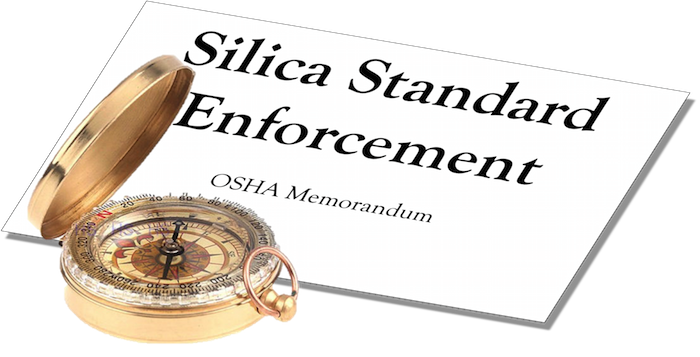Safety First News
OSHA's Playbook Revealed -Silica Enforcement Memo Published

October 22, 2017
The Occupational Safety & Health Administration (OSHA) released a memorandum for regional administrators on October 19, 2017, which establishes enforcement guidance for the agency regarding the Respirable Crystalline Silica in Construction Standard on an interim basis. The memo is essentially the playbook OSHA will follow regarding silica-related hazards, and represents an opportunity for construction employers to be better prepared for compliance.
The Silica Rule
The final rule on Occupational Exposure to Respirable Crystalline Silica, published on March 25, 2016, specified a new Permissible Exposure Limit (PEL) of 50 μg/m3 and a new Action Limit (AL) of 25 μg/m3 (both as an 8-hour time-weighted average under any foreseeable conditions) for all covered industries.
The new silica rule also established other worker protections, including requirements for employers to perform exposure assessments, using respiratory protections, offering medical surveillance, developing hazard communication information, and keeping records related to silica issues.
Enforcement for the construction silica standard was to commence on June 23, 2017, but OSHA postponed enforcement of the standard until September 23, 2017. Just before enforcement of the standard was to begin, OSHA announced during the first 30 days following September 23, 2017, the agency would offer compliance assistance to employers who were making a “good-faith” effort to comply with the standard. The assistance phase has now ended and “Effective October 23, 2017, OSHA will fully enforce all appropriate provisions of the Silica in Construction Standard,” according to the memo.
Enforcement Guidance
The OSHA enforcement memo will “serve as interim enforcement guidance while the standard’s companion compliance directive is proceeding through the review process.” OSHA says the enforcement guidance memo will expire when the compliance directive becomes effective and available to field enforcement staff.
Also noted in the memo was a stand-alone comment, seemingly slipped in, that says, “OSHA has revoked National Emphasis Program –Crystalline Silica.” There was no rationale offered other than the emphasis program was revoked “due to the new requirements in… [the] Respirable Crystalline Silica [standard].”
Inspection Procedures (Silica)
The memo is intended to be a guideline for Compliance Health & Safety Officers (CSHOs) when inspecting construction operations in which respirable crystalline silica (for the purposes of this article, “silica”) hazards potentially could exist. The guidance is presented in bullet list format, with a couple of flow charts to help the CSHOs.
The abbreviated bulleted list (aspects that may be of interest to employers) is presented here:
- CSHOs should be prepared to collect personal breathing zone samples on the first day of the inspection. Compliance officers will likely show up ready to collect air quality samples by affixing pumps and collection media to potentially affected workers to see to what extent the workers are exposed to silica.
- CSHOs must review the employer’s written silica Exposure Control Plan (ECP) and other relevant programs. The compliance officers must ask for the employer’s written silica ECP, so all construction employers who may be exposed to airborne silica, even if it is by the hands of another company’s workers, must have a written silica ECP. In addition, other associated written programs will likely be requested from the employer, including the:
- Respiratory protection program; and
- Hazard communication program
- Silica must be addressed in the HAZCOM program;
- Workers must have ready-access to silica-related safety data sheets (SDS);
- Workers must be trained regarding hazards and controls for silica;
- Even if worker exposures are below the silica action level (25 μg/m3), CSHOs are encouraged to cite employers for hazard communication deficiencies related to possible silica exposures.
- If the employer has conducted an exposure assessment, CSHOs should also review the assessment…
- Employers are not required to conduct air quality assessments of workers that are properly performing tasks as represented in the standard’s Table 1 tasks.
- The employer may utilize “objective data,” which is information (such as air monitoring data from industry-wide surveys, or calculations based on the composition of a substance) demonstrating worker exposure to silica associated with a particular product or material, or a specific process, task or activity. In order to qualify as “objective,” the data must “reflect workplace conditions closely resembling, or with a higher exposure potential, than the processes types of material, control methods, work practices, and environmental conditions present in the employer’s current operations,” according to the memo.
- If exposure air sampling was conducted, ensure qualified personnel are conducting the sampling and analysis to ensure OSHA will not have grounds to question the validity of the exposure assessment process.
- CSHOs should interview affected workers, including the competent person, as part of the overall assessment of the employer’s implementation of the exposure control plan (ECP). Workers with possible exposure to silica must receive training, informing the workers of the hazards of silica and how the hazards can be controlled. Although the competent person’s name does not have to be specified in the ECP, the workers need to know who the competent person is for the company.
Written Exposure Control Plan (Competent Person) The exposure control plan (ECP) must be implemented by the employer and it is to contain certain elements, such as:
- The employer must designate a competent person to conduct frequent and regular inspections of job sites, materials, and equipment to implement the written ECP.
- The competent person must be capable of identifying silica hazards in the workplace, have the authority to make prompt corrective actions, and have the knowledge and ability to fulfill responsibilities.
Housekeeping Practices
- The rule prohibits dry sweeping and dry brushing unless other methods (such as wet sweeping, HEPA-filtered vacuuming, etc.) are deemed by the employer not to be feasible. Be careful with trying to find a loophole here. For “feasibility,” OSHA would be looking for proof that other cleaning methods would not be effective, would cause damage, and/or would create a greater hazard in the workplace. Affordability is another aspect of “feasibility.” If the employer says the company cannot afford equipment that could assure compliance with the silica standard, OSHA could subpoena business tax records and financial records to determine how much, if any, profit the company has earned over the current or previous years. Again, the employer would bear the burden of proof to show that OSHA’s compliance requirements are not “feasible.”
- Using sweeping compounds like non-grit, oil-based, or wax-based compounds are an acceptable means for suppressing dust while sweeping.
- Compressed air for cleaning is only allowed when used in conjunction with a ventilation system that effectively captures the dust cloud created by the compressed air, or where no alternative method is feasible. There is that “feasible” word again. If the employer deems the only way to clear silica-infused dust is by compressed air only, the employer would have the burden of proof to establish no alternative method was feasible. We have heard OSHA Area Directors say on multiple occasions that infeasibility is virtually impossible to prove for employers. None of the OSHA Area Directors questioned about feasibility regarding any standard said they experienced a successful establishment of proof by an employer, although many have tried.
- The employer’s ECP must include the description of the housekeeping measure used to comply with the standard.
Medical Surveillance Employers must make a medical examination available to workers who will be required to wear a respirator for 30 days or more per year.
- OSHA says the 30-day trigger is applied per employer. In other words, if a worker was wearing a respirator for silica-related activities at Employer A, then immediately begins working for Employer B doing the same activities while wearing a respirator, the number of days the worker wore the respirator at Employer A would not be counted by Employer B.
- Dust masks like N-95 dust masks are considered respirators. While fit testing is not appropriate for dust masks, they are still respirators and would require medical surveillance procedures if the employer requires workers to wear them. If the workers are not required to wear respirators, the employer may allow them to wear them voluntarily, provided they sign a voluntary use form (also known as “Appendix D”), which can be found in the OSHA standard (29 CFR 1910.134 App D).
- Any partial day use of the respirator counts as one day’s use, even if the respirator is used for less than an hour.
- The employer must make the initial baseline medical examination available within 30 days after initial assignment of the worker (unless the worker has received a medical examination in keeping with the standard, within the previous three years.
- The documented medical opinion provided to the employer must only include the date of the exam, a statement from the licensed health care provider that the exam met the requirements of the standard, and any limitations on the worker’s use of the respirators.





